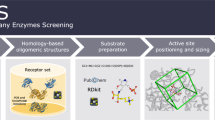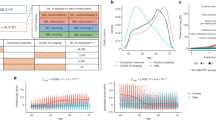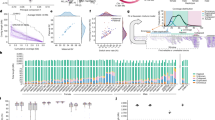Abstract
Peutz-Jeghers (PJ) syndrome is an autosomal-dominant disorder characterized by melanocytic macules of the lips, multiple gastrointestinal hamartomatous polyps and an increased risk for various neoplasms, including gastrointestinal cancer. The PJ gene was recently mapped to chromosome 19p13.3 by linkage analysis, with the highest lod score at marker D195886. In a distance of 190 kb proximal to D195886, we identified and characterized a novel human gene encoding the serine threonine kinase STK11. In a three-generation PJ family, we found an 5TK11 allele with a deletion of exons 4 and 5 and an inversion of exons 6 and 7 segregating with the disease. Sequence analysis of STK11 exons in four unrelated PJ patients has identified three nonsense and one acceptor splice site mutations. All five germline mutations are predicted to disrupt the function of the kinase domain. We conclude that germline mutations in STK11, probably in conjunction with acquired genetic defects of the second allele in somatic cells, cause the manifestations of PJ syndrome.
This is a preview of subscription content, access via your institution
Access options
Subscribe to this journal
Receive 12 print issues and online access
$209.00 per year
only $17.42 per issue
Buy this article
- Purchase on Springer Link
- Instant access to full article PDF
Prices may be subject to local taxes which are calculated during checkout
Similar content being viewed by others
References
Giardiello, P.M. et al. Increased risk of cancer in the Peutz-Jeghers syndrome. N. Engl.J.Med. 316, 1511–1514 (1987)
Spigelman, A.D ., Murday, V. & Phillips, R.K. Cancer and the Peutz-Jeghers syndrome. Gut 30, 1588–1590 (1989).
Hemminki, A . et al. Localization of a susceptibilty locus for Peutz-Jeghers syndrome to 19p using comparative genomic hybridization and targeted linkage analysis. Nature Genet. 15, 87–90 (1997).
Amos, C.I. et al. Fine mapping of a genetic locus for Peutz-Jeghers syndrome on chromosome 19p. Cancer Res. 57, 3653–3656 (1997)
Ashworth,, L.K. et al. An integrated metric physical map of human chromosome 19. Nature Genet. 11, 422–427(1995)
Schuler, G.D. et al. A gene map of the human genome. Science 274, 540–546 (1996)
Hall, S.L. & Padgett, R.A. Conserved sequences in a class of rare eukaryotic nuclear introns with non-consensus splice sites. J. Mol. Biol. 239, 357–365 (1994)
Su, J.Y., Erikson, E. & Mailer, J.L Cloning and characterization of a novel serine/threonine protein kinase expressed in early Xenopus embryos. J. Biol. Chem. 271, 14430–14437 (1996).
Hanks, S.K. & Hunter, T Protein kinases 6. The eukaryotic protein kinase superfamily: kinase (catalytic) domain structure and classification. FASEB J. 9, 576–596 (1995).
Steck, P.A. et al. Identification of a candidate tumour suppressor gene, MMAC1, at chromosome 10q23.3 that is mutated in multiple advanced cancers. Nature Genet. 15, 356–362(1997).
Liaw, D. et al. Germline mutations of the PTEN gene in Cowden disease, an inherited breast and thyroid cancer syndrome. Nature Genet. 16, 64–67 (1997).
Nishisho, I. et al. Mutations of chromosome 5q21 genes in FAP and colorectal cancer patients. Science 253, 665–669 (1991).
Joslyn, G. et al. Identification of deletion mutations and three new genes at the familial polyposis locus. Cell 66, 601–613 (1991)
Li, J. et al. PTEN, a putative protein tyrosine phosphatase gene mutated in human brain, breast, and prostate cancer. Science 275, 1943–1947 (1997)
Kinzler, K.W. et al. Identification of a gene located at chromosome 5q21 that is mutated in colorectal cancers. Science 251, 1366–1370 (1991).
Zimmer, M. et al. Three human elastase-like genes coordinately expressed in the myelomonocyte lineage are organized as a single genetic locus on 19pter. Proc. Natl. Acad. Sci. USA 89, 8215–8219 (1992).
Pilat, D. et al. The human Met-ase gene (GZMM): structure, sequence, and close physical linkage to the serine protease gene cluster on 19p13. Genomics 24, 445–450 (1994).
Rackwitz, H.R., et al. Analysis of cosmids using linearization by phage lambda terminase. Gene 40, 259–266 (1985).
Loff, S. et al. Peutz-Jeghers syndrome: cases at the Mannheim clinic over 25 years. Langenbecks Arch. Chir. 380, 43–52 (1995).
Author information
Authors and Affiliations
Rights and permissions
About this article
Cite this article
Jenne, D., Reomann, H., Nezu, Ji. et al. Peutz-Jeghers syndrome is caused by mutations in a novel serine threoninekinase. Nat Genet 18, 38–43 (1998). https://doi.org/10.1038/ng0198-38
Received:
Accepted:
Issue Date:
DOI: https://doi.org/10.1038/ng0198-38
This article is cited by
-
Progress report: Peutz–Jeghers syndrome
Familial Cancer (2024)
-
Current status of molecular diagnostic approaches using liquid biopsy
Journal of Gastroenterology (2023)
-
Advances in sex disparities for cancer immunotherapy: unveiling the dilemma of Yin and Yang
Biology of Sex Differences (2022)
-
RETRACTED ARTICLE: Multidisciplinary management for Peutz–Jeghers syndrome and prevention of vertical transmission to offspring using preimplantation genetic testing
Orphanet Journal of Rare Diseases (2022)
-
A novel missense mutation of the STK11 gene in a Chinese family with Peutz-Jeghers syndrome
BMC Gastroenterology (2022)



